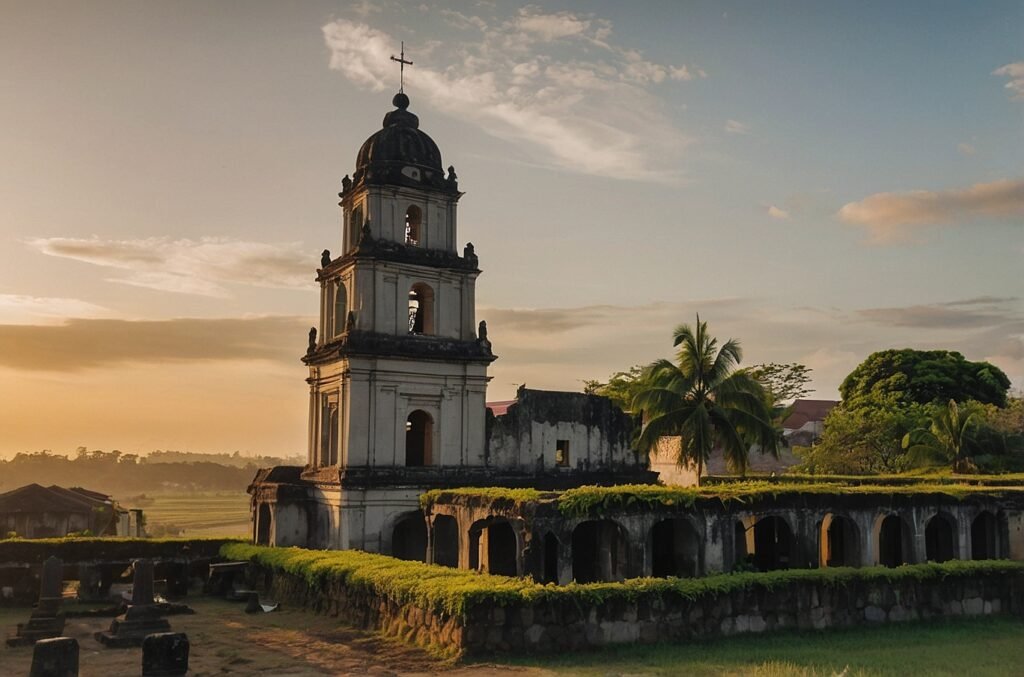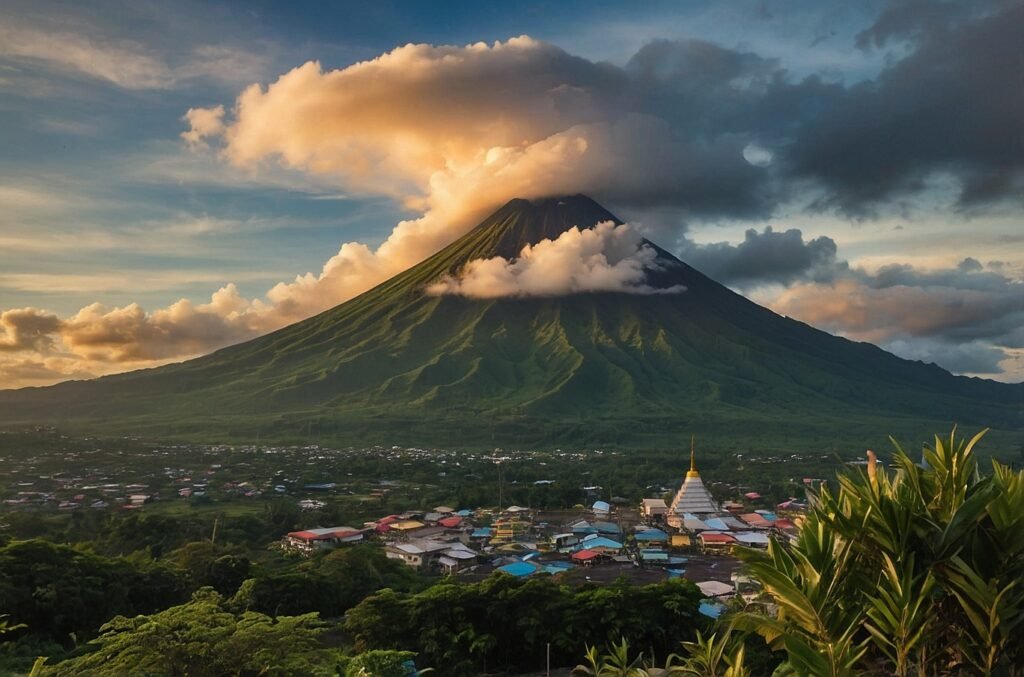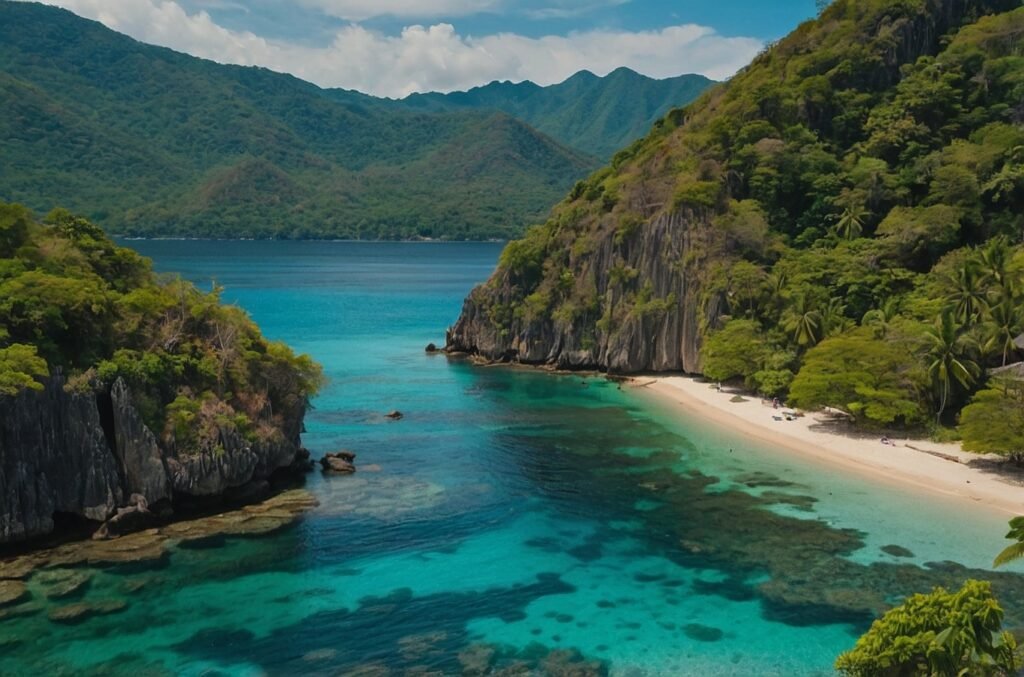Welcome, fellow travelers and history enthusiasts! Today, we’re embarking on a virtual journey to one of the Philippines’ most captivating destinations: Laoag City. Nestled in the heart of Ilocos Norte province, Laoag is a vibrant tapestry of colonial heritage, natural wonders, and warm Ilocano hospitality. As we explore this enchanting city, you’ll discover why Laoag has become a must-visit destination for those seeking a perfect blend of history, culture, and adventure. So, grab a cup of your favorite brew, sit back, and let’s unravel the wonders of Laoag together!
A Glimpse into Laoag’s Rich History
From Ancient Times to Spanish Colonial Era
Laoag’s story begins long before recorded history, with evidence of human habitation dating back thousands of years. The name “Laoag” itself comes from the Ilocano word “lawag,” meaning “light” or “brightness,” a fitting moniker for a city that has long been a beacon of culture in the region. As we delve into Laoag’s past, we find a fascinating timeline of events that shaped the city we see today.
The arrival of the Spanish in the 16th century marked a significant turning point in Laoag’s history. Under Spanish rule, Laoag became an important colonial outpost, serving as a vital link between the northern Philippines and the rest of the Spanish Empire. This period saw the construction of many of the city’s iconic structures, including the majestic St. William’s Cathedral and the famous Sinking Bell Tower. These architectural marvels stand as testament to the enduring influence of Spanish colonialism on Laoag’s cultural landscape.
American Period and Modern Times
The dawn of the 20th century brought new changes to Laoag with the arrival of American colonizers. This era saw significant developments in education, infrastructure, and governance, laying the groundwork for Laoag’s transformation into a modern city. Despite these changes, Laoag managed to preserve much of its colonial charm and Ilocano traditions, creating a unique blend of old and new that continues to captivate visitors today.
In recent decades, Laoag has emerged as a thriving urban center, balancing economic growth with the preservation of its rich cultural heritage. The city’s designation as a component city in 1965 marked a new chapter in its history, paving the way for increased development and tourism initiatives that have put Laoag on the map as a prime destination in Northern Luzon.
Natural Wonders: Laoag’s Geographic Marvels
Landscapes That Take Your Breath Away
Laoag isn’t just about history; it’s also blessed with stunning natural beauty that will leave you in awe. The city is situated in a picturesque valley, flanked by the Cordillera Central mountains to the east and the South China Sea to the west. This unique geography creates a diverse landscape that includes everything from golden beaches to rolling hills and lush forests.
One of the most striking natural features of Laoag is the Paoay Lake, a serene body of water surrounded by myths and legends. Local folklore suggests that the lake was once a prosperous village that sank due to the villagers’ greed and excess. Whether you believe the legend or not, the lake’s tranquil waters and scenic surroundings make it a perfect spot for relaxation and reflection.
Climate and Biodiversity: A Year-Round Paradise
Laoag enjoys a tropical savanna climate, characterized by two distinct seasons: a dry season from November to April and a wet season from May to October. This climate pattern contributes to the region’s rich biodiversity, supporting a wide array of flora and fauna. Nature lovers will find plenty to explore in the nearby forests and coastal areas, home to numerous bird species, mammals, and marine life.
To give you a better idea of Laoag’s climate, here’s a table showing the average monthly temperatures and rainfall:
| Month | Avg. High (°C) | Avg. Low (°C) | Rainfall (mm) |
|---|---|---|---|
| January | 30 | 20 | 5 |
| February | 31 | 20 | 7 |
| March | 32 | 21 | 9 |
| April | 34 | 23 | 20 |
| May | 34 | 24 | 89 |
| June | 33 | 24 | 186 |
| July | 32 | 24 | 330 |
| August | 31 | 24 | 401 |
| September | 32 | 24 | 248 |
| October | 31 | 23 | 140 |
| November | 31 | 22 | 48 |
| December | 30 | 21 | 13 |
As you can see, Laoag offers pleasant temperatures year-round, making it an ideal destination regardless of when you choose to visit. Just be sure to pack an umbrella if you’re planning a trip during the wet season!
Cultural Tapestry: The Heart of Laoag
Festivals and Traditions: Celebrating Ilocano Heritage
One of the best ways to experience the vibrant culture of Laoag is through its colorful festivals and time-honored traditions. The city comes alive during these celebrations, offering visitors a chance to immerse themselves in authentic Ilocano culture. Here are some of the must-see festivals in Laoag:
- Pamulinawen Festival: Held every February, this festival honors Laoag’s patron saint, William the Hermit. The streets come alive with colorful parades, street dancing, and various cultural performances.
- Gameng Festival: This celebration of Ilocano heritage takes place in May, showcasing traditional crafts, cuisine, and cultural presentations.
- Guling-Guling Festival: Occurring on the eve of Ash Wednesday, this pre-Lenten carnival features street parties, masked dancers, and the sharing of the local delicacy called “guling” (round rice cakes).
These festivals not only provide entertainment but also offer a window into the deep-rooted traditions and values of the Ilocano people. The warm hospitality and genuine enthusiasm of the locals during these events make for an unforgettable cultural experience.
Culinary Delights: A Feast for the Senses
No exploration of Laoag’s culture would be complete without diving into its mouthwatering cuisine. Ilocano food is known for its bold flavors and unique ingredients, reflecting the region’s agricultural abundance and coastal location. Here are some local delicacies you simply must try:
- Bagnet: A crispy deep-fried pork belly dish that’s a true indulgence for meat lovers.
- Pinakbet: A vegetable stew made with bitter melon, eggplant, okra, and other local produce, often flavored with bagoong (fermented fish paste).
- Empanada Ilocano: A savory pastry filled with green papaya, mung beans, and longganisa (local sausage), deep-fried to golden perfection.
- Dinengdeng: A vegetable soup flavored with grilled fish, perfect for those seeking a lighter option.
These dishes not only tantalize your taste buds but also tell the story of Laoag’s cultural influences and agricultural heritage. Don’t be surprised if you find yourself craving these flavors long after your visit!
Architectural Marvels: Laoag’s Living History
St. William’s Cathedral: A Baroque Masterpiece
Standing proudly in the heart of Laoag is the magnificent St. William’s Cathedral, a stunning example of Baroque architecture that has withstood the test of time. Built in 1612, this historic church is not just a place of worship but a living testament to the city’s colonial past. The cathedral’s imposing facade, adorned with intricate carvings and massive columns, is a sight to behold. Step inside, and you’ll be greeted by a serene interior featuring beautiful altars, religious paintings, and a sense of tranquility that transports you back in time.
What makes St. William’s Cathedral truly unique is its blend of European and Filipino design elements. The structure incorporates earthquake baroque features, a architectural style developed in response to the Philippines’ seismic activity. This fusion of form and function showcases the ingenuity of colonial-era builders and the resilience of Laoag’s architectural heritage.
The Sinking Bell Tower: A Leaning Wonder
Just a stone’s throw away from the cathedral stands another of Laoag’s iconic landmarks: the Sinking Bell Tower. This curious structure, built in the late 17th century, has been slowly sinking into the ground at a rate of about an inch per year. Legend has it that the tower was so heavy that it began sinking into the sandy soil immediately after construction. Despite its gradual descent, the tower remains an impressive sight, standing at over 45 meters tall.
The Sinking Bell Tower’s unique tilt and ornate design make it a favorite subject for photographers and history buffs alike. Its resilience in the face of natural forces serves as a metaphor for Laoag itself – a city that stands strong and proud despite the challenges of time and nature.
Colonial Houses: Windows to the Past
As you wander through Laoag’s streets, you’ll encounter numerous well-preserved colonial houses that offer glimpses into the city’s bygone era. These ancestral homes, with their distinctive architecture featuring capiz shell windows, wide verandas, and intricate woodwork, tell the stories of Laoag’s prominent families and the lifestyle of the colonial elite.
One such example is the Mansion House, a stately residence that now serves as a museum. Its grand interiors, filled with period furniture and artifacts, provide a fascinating look at the opulent lifestyle of Laoag’s upper class during the Spanish and American colonial periods.
Natural and Man-Made Attractions: Beyond the City Limits
Sand Dunes: An Unexpected Desert Adventure
Just a short drive from Laoag’s city center lies one of the Philippines’ most unexpected attractions: the La Paz Sand Dunes. This sprawling desert-like landscape covers an area of over 85 square kilometers, offering visitors a thrilling taste of adventure in an otherwise tropical setting. The undulating dunes, some reaching heights of up to 30 meters, create a surreal backdrop that has caught the eye of filmmakers and tourists alike.
For the adventurous souls, the sand dunes offer a playground of exciting activities:
- Sandboarding: Slide down the dunes on specially designed boards for an adrenaline-pumping experience.
- 4×4 Rides: Buckle up for a heart-racing ride over the dunes in rugged off-road vehicles.
- Photography: Capture stunning landscapes, especially during sunrise or sunset when the dunes are bathed in golden light.
The juxtaposition of these desert-like dunes against the backdrop of the South China Sea creates a truly unique ecosystem that’s worth exploring. It’s a testament to the diverse natural wonders that Laoag and its surrounding areas have to offer.
Paoay Church: A UNESCO World Heritage Site
While technically located in the neighboring town of Paoay, no visit to Laoag would be complete without a trip to the awe-inspiring Paoay Church. Recognized as a UNESCO World Heritage Site, this architectural marvel is one of the best examples of Baroque churches in the Philippines. Built in 1710, the church is renowned for its distinctive earthquake baroque style, featuring massive buttresses that support its coral stone and brick structure.
The church’s facade is a stunning blend of Gothic, Baroque, and Oriental influences, creating a unique architectural style that’s come to be known as “Earthquake Baroque.” The massive buttresses, which give the church its fortress-like appearance, were designed to withstand the frequent earthquakes in the region. As you explore the church and its surroundings, you’ll be struck by the intricate details and the sheer scale of this centuries-old structure.
Here’s a quick overview of Paoay Church’s key features:
- Construction: Started in 1694, completed in 1710
- Architectural Style: Earthquake Baroque
- Materials: Coral stone, brick, and wood
- Notable Features: 24 massive buttresses, ornate facade, separate bell tower
- UNESCO Recognition: Inscribed as a World Heritage Site in 1993
Sustainable Tourism: Preserving Laoag for Future Generations
Eco-Friendly Initiatives
As Laoag continues to grow as a tourist destination, there’s an increasing focus on sustainable tourism practices to preserve the city’s natural and cultural heritage. Local government and community organizations are working together to implement eco-friendly initiatives that allow visitors to enjoy Laoag’s attractions while minimizing their environmental impact.
Some of these initiatives include:
- Waste Management Programs: Improved recycling facilities and education campaigns to reduce litter in tourist areas.
- Green Transportation: Promotion of bicycle rentals and walking tours to explore the city center.
- Conservation Projects: Efforts to protect and restore natural habitats, particularly in coastal areas and the sand dunes.
- Community-Based Tourism: Support for local artisans and small businesses to ensure tourism benefits the local economy.
Visitors can contribute to these efforts by being mindful of their environmental impact, supporting local businesses, and participating in eco-friendly tours and activities.
Responsible Travel Tips
To help you make the most of your visit to Laoag while being a responsible traveler, here are some tips to keep in mind:
- Respect local customs and dress codes, especially when visiting religious sites.
- Support local artisans by purchasing authentic handicrafts and souvenirs.
- Conserve water and energy in your accommodations.
- Use refillable water bottles to reduce plastic waste.
- Participate in local conservation efforts or volunteer programs if you have the time.
- Learn a few phrases in Ilocano to connect with locals and show respect for the culture.
By following these guidelines, you’ll not only enhance your own experience but also contribute to the preservation of Laoag’s unique charm for future generations to enjoy.
Planning Your Visit: Practical Tips for Travelers
Getting There and Around
Laoag is well-connected to major cities in the Philippines, making it easily accessible for both domestic and international travelers. Here are your main options for reaching this captivating city:
- By Air: Laoag International Airport serves several domestic flights from Manila and other major cities. There are also occasional international flights from select Asian destinations.
- By Land: Long-distance buses operate regular routes from Manila to Laoag, offering a scenic (albeit lengthy) journey through the countryside.
- By Private Vehicle: If you’re up for a road trip, driving from Manila to Laoag takes about 10-12 hours, allowing you to explore other destinations along the way.
Once in Laoag, getting around is relatively easy:
- Tricycles: These three-wheeled vehicles are the most common form of local transport for short distances.
- Jeepneys: For longer trips within the city or to nearby towns, jeepneys are an affordable and quintessentially Filipino way to travel.
- Car Rentals: Available for those who prefer more flexibility in exploring the region.
Best Time to Visit
While Laoag is a year-round destination, the best time to visit depends on your preferences and planned activities. Here’s a quick guide:
- December to February: Coolest and driest months, ideal for outdoor activities and sightseeing.
- March to May: Hottest months, perfect for beach trips but can be uncomfortably warm for extensive touring.
- June to November: Wet season, with potential for typhoons. However, this period offers lush green landscapes and fewer crowds.
For festival-goers, planning your trip around Laoag’s major celebrations can add an extra layer of cultural immersion to your visit.
Conclusion: Your Gateway to Ilocano Culture and Natural Beauty
As we wrap up our journey through Laoag, it’s clear that this vibrant city offers a unique blend of historical charm, natural wonders, and cultural richness. From the towering sand dunes to the intricate details of colonial architecture, from the mouthwatering local cuisine to the warm smiles of the Ilocano people, Laoag presents a tapestry of experiences that will leave a lasting impression on any traveler.
Whether you’re a history buff, a nature enthusiast, a foodie, or simply someone looking to immerse yourself in a new culture, Laoag has something special to offer. Its strategic location also makes it an ideal base for exploring the wider Ilocos region, including the historic city of Vigan and the beautiful beaches of Pagudpud.
As you plan your visit to Laoag, remember that the true magic of this city lies not just in its sights and sounds, but in the stories and traditions passed down through generations. Take the time to chat with locals, savor the flavors of Ilocano cuisine, and allow yourself to be swept up in the rhythm of life in this enchanting corner of the Philippines.
So pack your bags, bring your sense of adventure, and prepare to be captivated by Laoag – a city where history whispers from every corner, where nature paints breathtaking landscapes, and where the warmth of Ilocano hospitality will make you feel right at home. Your journey through the “City of Light” awaits, promising memories that will shine brightly long after you’ve returned home.
Disclaimer: While every effort has been made to ensure the accuracy of the information presented in this blog post, details may change over time. We encourage readers to verify current information before planning their trip. If you notice any inaccuracies, please report them so we can promptly correct them. This blog post is intended for informational purposes only and should not be considered as professional travel or safety advice.




